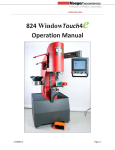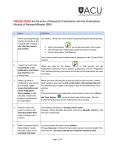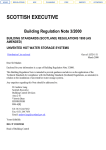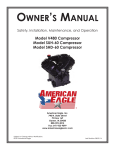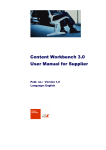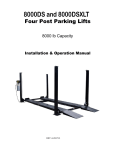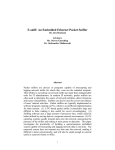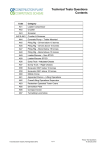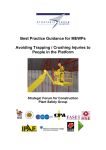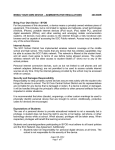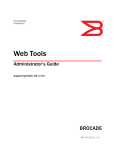Download The Delivery Hub health, safety and environment Raising the bar 3
Transcript
Safe roads, reliable journeys, informed travellers The Delivery Hub health, safety and environment Raising the bar 3 Man/machine interface Version I - July 2012 An executive agency for the Department for Transport THE DELIVERY HUB HEALTH, SAFETY AND ENVIRONMENT - RAISING THE BAR 3 Man/machine interface - Version I - JULY 2012 2 Contents Scope Page 3 Position Page 3 Man/machine interface proximity sensor review Page 4 Summary Page 9 Next steps Page 9 << Contents Email: [email protected] THE DELIVERY HUB HEALTH, SAFETY AND ENVIRONMENT - RAISING THE BAR 3 Man/machine interface - Version I - JULY 2012 3 Scope This document applies to works delivered for the Highways Agency on the Major Projects delivery programme. Position Following a review and trial of a variety of proximity sensors on the market (see appendix 1), there is no single solution. All sites should risk assess the need for proximity sensors as part of their hierarchy of control but ensure that the following basic controls are always in place: • Ensure that pedestrians not associated with the task and vehicles are segregated. Those pedestrians associated with the task must have a clear method of communication with the machine operator and remain within his sight at all times. • Ensure that any reversing vehicles (other than cars or car derived vans) are either in a pedestrian exclusion zone or if this is not possible, banked by a competent traffic marshal who is positioned in a place of safety. • Never allow anyone to be positioned within a metre of the body of an operational vehicle and a static object (another piece of plant/a wall/ etc) • Ensure that everyone on site, including visitors are aware of the pedestrian and vehicle routes. • Set up one way systems and drive through loading/unloading bays. << Contents Email: [email protected] THE DELIVERY HUB HEALTH, SAFETY AND ENVIRONMENT - RAISING THE BAR 3 Man/machine interface - Version I - JULY 2012 4 Man/machine interface proximity sensor review Ref System Trial by Summary Positives: The system is very robust. The transponders are sealed units and not affected by weather. The antennae unit is very durable. Larger machines can have more antennae added to give very full coverage of the machine or you can concentrate coverage for a specific area such as the counterweight of the machine. The plant operator can temporarily silence the alarm but has to continually hold a button to continually silence the alarm. This prevents him from operating the plant machinery at the same time so making pedestrian access to the plant machinery for communication or slinging loads safe. A-Plant is seriously considering fitting this to all machines – excavators and dumpers – that Costain hire and then selling the transponders as consumables. A lot cheaper than buying the units. The Transponders work for all sender units so any surviving the end of the contract can be used elsewhere. Also the same transponder will alarm any number of sender units the holder approaches. 1.1 Ongrade ZoneSafe Walters at Costain, Port Talbot Drivers are issued with a transponder thus making two machines capable of `seeing` each other and thus avoid two machines colliding. The system is also designed in such a way that the driver’s transponder will not trigger the alarm while in the machine. Minus side: Any rogue person without a transponder will be subject to a high risk of being struck by machinery if they enter the works area of the machine under the Zonesafe system as they will not trigger an alarm and the plant operators awareness of them will be limited due to reliance on the Zonesafe system. Most people struck by the bucket end of the machine are done so as the machine slews to the right, this is the blind side of the plant operator. In a fairly large machine such as 30t excavator with the bucket at near full reach the bucket might be outside the max zone of the antennae and will put people on the right of the furthest reach of the machine in a potential position of danger with both the pedestrian and plant operator thinking they are safe. Work where pedestrians work closely with plant machinery such as drainage is going to cause the alarm to constantly go off and will lead to operatives finding ways to circumnavigate the system. The system is presently relatively expensive. To set up a unit on a fairly big machine such as 20t excavator with 2 or 3 antennae would cost in the region of £4000. That is a big outlay for any subcontractor, and that does not include the transponders - £70 apiece. The price quoted is for individual units, the more you buy, the lower the cost. continued << Contents Email: [email protected] THE DELIVERY HUB HEALTH, SAFETY AND ENVIRONMENT - RAISING THE BAR 3 Man/machine interface - Version I - JULY 2012 5 Ref 1.2 System Ongrade Zonesafe Trial by McArdle – M25 Summary Operatives on the ground have developed a change in culture actively giving plant machinery a wide berth so as not to trigger the alarm. The trial has shown that the existing gated system is proving successful, with the earthworks activities being excluded to other personnel. This can be seen within the recorded data and the non activation of system by the representative transponder carriers as listed above. 1.3 Ongrade is still relatively new technology that needs further revisions and adaptations to make it work successfully. Revisions required to make the system more successful in operations would be: 1 Location monitor to show where the personnel wearing transponder has breached the exclusion zone. This would allow retrieval of data to indicate possible hot spot intrusions. Ongrade Zonesafe 2 Increase in radius exclusion zone to 10-12m to allow for rapid movement of reversing plant such as tractor dozers, loading shovels and self propelled/ ride on rollers working on formation type activities. 3 The absolute necessity to ensure that every person on site carries a transponder at all times including all site visitors as plant operators would naturally expect the system to be warning them of any unauthorised intrusion. It would be advantageous now to trial the system in a different situation in a more open green field site on an operation utilising different plant such as dozer operations placing capping or fill materials. 1.4 Ongrade Zonesafe Balfour Beatty and Skanska JV M25 Section 1 The machine could still be operated with the alarm sounding. During this demonstration, an engineer (not part of the demonstration) wandered into the danger area and as he did not have a Tag, the alarm did not sound. This is a major failing with regard to maintaining a safe zone. No user manual was available in the cab and McArdle do not yet have a program of inspection with regard to this system; something which is required as a matter of urgency. This system could be a useful tool in the box, but only where there is a tightly controlled working area and not a location that is open to a variety of user groups. It could not be used where there is a possible public interface i.e. street works. There is also a possibility that the plant operator could become reliant on the system and not notice non-tag holders entering the danger areas. Tags are £35 each, lasting two years (still to be confirmed). Uniquely tagged. Could be done at daily briefings. Can identify who breaks safety zone/how often. Can change shape of zone. 1.5 Ongrade Zonesafe Balfour Beatty M25 Section 1 Product has been on use on site for approx 6 months with no failure. This product does not currently immobilise the plant, McArdles hope to connect the device to the plant hydralics sometime in the future, without this the product is only a warning device. This system could be a useful tool in the box, but only where there is a tightly controlled working area and not a location that is open to a variety of user groups i.e. public interface. There is also a possibility that the plant operator could become reliant on the system and not non-tag holders entering the danger areas. continued << Contents Email: [email protected] THE DELIVERY HUB HEALTH, SAFETY AND ENVIRONMENT - RAISING THE BAR 3 Man/machine interface - Version I - JULY 2012 6 Ref System Trial by Summary The system was demonstrated using a dummy mounted on a 250 litre oil drum. The shovel was backed, at some speed, towards the object and successfully came to a halt approx 3 metres from the dummy. Further tests came up with the same results. The operator set the system at the best sensitivity and the machine came to a halt approx 2.5 metres from the dummy. 2 Ogden reversing radar Balfour Beatty and Skanska JV M25 Section 1 According to McArdles representative, the system had been set up to activate approx 4 metres from an obstruction, which if this is the case, indicates that considering the speed of the machine and the inertia, the system was more than capable of reacting in time. An over reliance on the system could lead to loss of concentration by the driver. No user manual was available in the cab and McArdle do not yet have a program of inspection with regard to this system; something which is required as a matter of urgency. 3 ROCS (remote operation cut-off system) Balfour Beatty and Skanska – SEESA Tilbury sub station Ideal product where work area has general public / operatives in close proximity to machine such as roadworks, shuttering, confined or restricted areas. Stops tracks and boom instantly. Kills engine revs. Easy to use by banksman. When activated, gives audio/visual indication to excavator operator (cab fitted). Colour coded buttons on remote hand held device plus LED. LED flashes once during normal operation or 6 times if battery low charge. Remote clips to banksman belt and approx weight of mobile phone. Main module sealed and believed to be tamper proof. No restriction on size of machine and has been tested on 2.5 tonne to 22.5 tonne excavators. Creates a magnetic marker field around machinery using a field Generator Installed on the machine. The generator creates low-frequency electromagnetic signals to mark areas consider to be potentially hazardous. The field can encompass the entire machine and its turning radius or be specific to certain areas. Ops wear a personal-alarm devise (PAD) that detects and measures the magnetic marker field and alert them of possible danger to their safety: 4 Hazard avert Balfour Beatty • Hazard avert generators can be installed to any/all types of mining machinery and vehicles about and below ground • Each miner to have an individualised unit • Multiple machines and multiple users can work without conflict • Does not affect environment • Low frequency passes through almost anything incl coal, rock, dust and water • Easily configured • Workers entering and leaving zones and the duration of time spent in the zones are recorded and saved to the TDP data-logger • Data can be downloaded an analysed. No trial feedback continued << Contents Email: [email protected] THE DELIVERY HUB HEALTH, SAFETY AND ENVIRONMENT - RAISING THE BAR 3 Man/machine interface - Version I - JULY 2012 7 Ref 5.1 System AVM scene analysis Trial by Balfour Beatty Ground Engineering Summary Three to four cameras mounted around the plant or vehicle. All images joined together by the software to provide a overview birds eye view around plant or vehicle. Uses analysis software to alert operator if someone strays into close proximity to the machine. Provides a single point of focus for the operator to see all round the vehicle rather than looking at numerous mirrors, rear cameras and the banksman: • High resolution colour cameras • 160 degree angle of visability with one camera • Night vision enabled • Cameras mounted around the plant or vehicle to give 270 or 360 degree vision • Cameras face down and not prone to glare from the sun • Camera is set for 3m around view of the plant or vehicle • Monitor can switch to full screen when a turn is made • Alarm sounds and red light flashes if movement is detected Six hour recording mode is available and is saved on SD card. Manufacturer is working on the software and processor to increase functionality. Awaiting trial feedback. 5.2 AVM Bam/Morgan Sindall with Vision techniques New concept which has not yet been proven but Vision Techniques are expecting samples by the end of the year. It comprises of four cameras mounted all round the vehicle where the pictures from the camera would overlap. By using special video software the pictures are stitched together to form one easily understood birds eye view around a vehicle so by looking at one monitor rather than 4-5 mirrors a complete overview can be achieved of any dangers around a vehicle. The equipment will also incorporate software that allows you to define a close protection zone around the vehicle and should anybody enter this. continued << Contents Email: [email protected] THE DELIVERY HUB HEALTH, SAFETY AND ENVIRONMENT - RAISING THE BAR 3 Man/machine interface - Version I - JULY 2012 8 Ref System Trial by Summary The Becker electronics Collision Avoidance system (CAS) provides an early warning indication that brings to his/her attention the presence and the number of personnel and/or vehicles in his vicinity. Using a combination of vehicle and control tags, antennas and video equipment Becker Mining Solutions have various systems to mitigate a wide range of potential hazards whilst mining. These include: 6 Becker Mining Solutions Bekercas Balfour Beatty • Vehicle to vehicle awareness • Miner to vehicle to awareness • Hazardous zone awareness • Simple messaging to miner tags • Multimode operation (near and far fields) • Accident investigation support • Integration with tagging systems and communications networks • Ability to locate tags or equipment • Learning capability for miner and vehicles working consistently together. Key features include: • RFI vehicle and personnel detection • Integrated high intensity audio alarm • 2 x 7 segment LCD (vehicle and personnel) • System self test • Mulitple antenna types (DPOD ready) • Modular design trail details expected from Crossrail, Paul Hoyland. << Contents Email: [email protected] THE DELIVERY HUB HEALTH, SAFETY AND ENVIRONMENT - RAISING THE BAR 3 Man/machine interface - Version I - JULY 2012 9 Ref System Trial by Summary Excavators are short radius or zero swing. Short radius excavators vastly reduce and in the case of zero swing eliminate the area where people could be trapped by the side/rear/counter weight of the excavators. Trialling of a speaker system on their excavators, when the excavator is tracked forwards or backwards, the speaker sounds and the words “caution machine in motion“ can be heard. 7 Rouse working practices Bam/Morgan Sindall M62 When the switch for the quick hitch is engaged the speaker sounds “caution stand well clear”. This is audible until the quick hitch cycle is complete and the switch is flicked back to the off position. These speaker systems are retro-fitted to the excavators in K Rouse head office workshop, by their team of technicians. They provide pocket-less hi-viz trousers and long sleeve hi-viz t-shirts for the excavator drivers, to ensure that loose/open pockets from coats or trousers do not catch the joystick controls of the excavator. This has been trialled on a previous site and proved very successful. They have a policy that requires any of their workforce entering the work area to stop the excavator or speak to the operator, then the operator must finish/stop what he is doing, place his bucket on the ground, raise the dead man lever in the cab and turn the engine of the excavator off before that person can enter the radius of the excavator. Summary Ongrade Zonesafe May be part of a hierarchy of control but is not the solution to prevent injuries from plant as the system does not fail safe and the likelihood of a third party without a transponder walking into the danger zone is too high. Odgen reversing radar Positive results from initial test. Further testing in varying environments needed to confirm initial results. AVM Feedback from BB trial required once completed. Bekercas Results from Crossrail required. Rouse Good practice that appears relatively simple to implement. Next steps 1 This document will be updated with results of further trials when available. ROCS Positive results from initial test. Needs consideration of any hazard introduced by immediately stopping – spilt load etc. 2. Conduct further trials or gain reports from completed trials of Ogden reversing radar, ROCS, Hazard avert, AVM and Bekercas. Hazard avert Trial needed if this is to be considered. 3. Next stage of Zonesafe (site safe system) being trailed by Carillion at Birmingham Box. << Contents Email: [email protected] If you need help using this or any other Highways Agency information, please call 0300 123 5000 and we will assist you. © Crown copyright 2012. You may re-use this information (not including logos) free of charge in any format or medium, under the terms of the Open Government Licence. To view this licence, visit http://www.nationalarchives.gov.uk/doc/open-government-licence/ or write to the Information Policy Team, The National Archives, Kew, London TW9 4DU, or email: [email protected]. This document is also available on our website at www.highways.gov.uk If you have any enquiries about this publication email [email protected] or call 0300 123 5000 Please quote Highways Agency publications code PR83/12 Highways Agency media services Bedford S120431 THE DELIVERY HUB HEALTH, SAFETY AND ENVIRONMENT - RAISING THE BAR 3 Man/machine interface - Version I - JULY 2012











